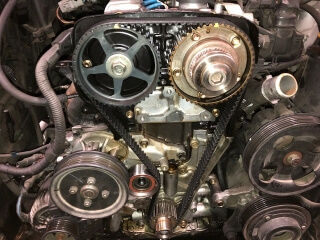TIMING BELT REPLACEMENT IN SAN RAMON

Your car’s timing belt is an integral part of the engine, controlling the rate at which valves open and close to ensure proper operation. Unfortunately, unlike many engine parts, your timing belt doesn’t slowly wear down and function less efficiently over time. When the timing belt wears out, it will simply snap, causing your car’s engine to stop running at best, and damaging other parts of the engine at worst. Having your timing belt replaced by an auto repair professional is a simple procedure that could save you extensive engine repairs in the future. Walt’s Danville Service is pleased to offer timing belt replacement in addition to other auto maintenance near San Ramon.
HOW THE TIMING BELT WORKS
The timing belt plays an essential role in engine function, providing the precision needed to keep every moving part in perfectly-timed sync. A timing belt is a rubber belt infused with fiber cords for added strength and shaped with teeth that fit into grooves on the camshaft and crankshaft, connecting them and linking their motion. As the crankshaft turns, it converts the energy from your engine’s pistons into the motion of your car’s wheels. At the same time, the camshaft opens and closes valves within your engine to control the flow of air and gas. Without a properly-functioning timing belt, the valves and pistons inside your engine would not operate on the right timescales—the pistons would hit the valves and cause extensive damage to the engine.
WHEN IT’S TIME FOR TIMING BELT REPLACEMENT
How will you know when it’s time to replace your timing belt? There are a few guidelines and indicators you can follow:
- Check your timing belt periodically for damage, discoloration, or wear. You can access the timing belt by lifting or unscrewing the plastic cover that protects it at the front of your engine. If you aren’t sure how to find the timing belt, your auto repair specialist can show you during your next car maintenance visit. Alternatively, your technician can check the belt for you during every 10,000-mile tune-up.
- Check your car’s manual to find more information on when the belt should be replaced. Most timing belts should be replaced between 60,000 and 100,000 miles; your manual will have more detailed information. Even if your timing belt appears to be in decent shape once you hit its expected lifespan, it’s still a good idea to replace it. The cost of this preventive measure will be far less than the cost of engine repair if the belt snaps.
Do you have questions about your timing belt or any other component of your engine? Contact Walt’s Danville Service today for honest, expert advice and auto repair service.